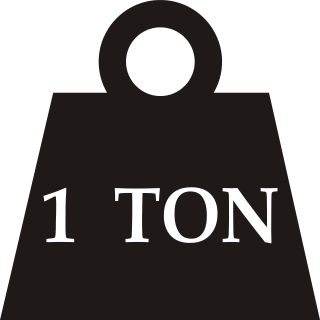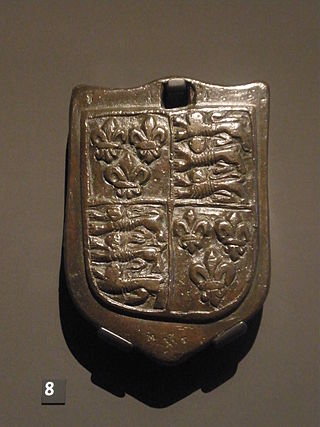Related Research Articles

The pound or pound-mass is a unit of mass used in both the British imperial and United States customary systems of measurement. Various definitions have been used; the most common today is the international avoirdupois pound, which is legally defined as exactly 0.45359237 kilograms, and which is divided into 16 avoirdupois ounces. The international standard symbol for the avoirdupois pound is lb; an alternative symbol is lbm, #, and ℔ or ″̶.

Ton is any of several units of measure of mass, volume or force. It has a long history and has acquired several meanings and uses.

The mole (symbol mol) is the unit of measurement for amount of substance, a quantity proportional to the number of elementary entities of a substance. It is a base unit in the International System of Units (SI). One mole contains exactly 6.02214076×1023 elementary entities (approximately 602 sextillion or 602 billion times a trillion), which can be atoms, molecules, ions, or other particles. The number of particles in a mole is the Avogadro number (symbol N0) and the numerical value of the Avogadro constant (symbol NA) expressed in mol-1. The value was chosen based on the historical definition of the mole as the amount of substance that corresponds to the number of atoms in 12 grams of 12C, which made the mass of a mole of a compound expressed in grams numerically equal to the average molecular mass of the compound expressed in daltons. With the 2019 redefinition of the SI base units, the numerical equivalence is now only approximate but may be assumed for all practical purposes.
The long ton, also known as the imperial ton or displacement ton, is a measurement unit equal to 2,240 pounds (1,016.047 kg). It is the name for the unit called the "ton" in the avoirdupois system of weights or Imperial system of measurements. It was standardised in the 13th century. It is used in the United Kingdom and several other Commonwealth of Nations countries alongside the mass-based tonne defined in 1799, as well as in the United States for bulk commodities.

A bushel is an imperial and US customary unit of volume based upon an earlier measure of dry capacity. The old bushel is equal to 2 kennings (obsolete), 4 pecks, or 8 dry gallons, and was used mostly for agricultural products, such as wheat. In modern usage, the volume is nominal, with bushels denoting a mass defined differently for each commodity.
The batman was a unit of mass used in the Ottoman Empire and among Turkic peoples of the Russian Empire. It has also been recorded as a unit of area in Uyghur-speaking regions of Central Asia. The name is Turkic, but was also sometimes used for the equivalent unit in Persia. The equivalent unit in British India was anglicized as the maund. The value of the batman varied considerably from place to place.

The stone or stone weight is an English and British imperial unit of mass equal to 14 pounds (6.35 kg). The stone continues in customary use in the United Kingdom and Ireland for body weight.
A number of different units of measurement were used in Argentina as its national system was derived from Spanish Castillian. The metric system was legally optional since 1863 and has been compulsory since 1887.
A number of different units of measurement were used in Bolivia to measure, for example, mass. Older system was basically derived from Spain. In Bolivia, International Metric system was legally optional since 1871, and International Metric system has been compulsory since 1893 even though, even in 1890s also, metric system was recognised at the custom-houses and other units which were of Spanish origin was also used.
A number of units of measurement were used in Cuba to measure quantities like mass, area, and capacity. In Cuba, Metric system has been compulsory since 1858.
Traditional Greek units of measurement were standardized and used in modern Greece before and alongside the adoption of the metric system in 1836. Metric units were finally made legally compulsory in 1922.
A number of units of measurement were used in Guinea to measure length, mass, etc. Since 1910, the metric system has been compulsory in Guinea.
A number of units of measurement were used in Hungary to measure length, area, volume, and so on. The metric system was adopted in Hungary in 1874 and has been compulsory since 1876.
A number of units of measurement were used in Indonesia to measure length, mass, capacity, etc. Metric system adopted in 1923 and has been compulsory in Indonesia since 1938.
A number of units of measurement were used in Morocco to measure length, mass, capacity, etc. Metric system has been compulsory in Morocco since 1923.
A number of units of measurement were used in Oman.
A number of different units of measurement were used in Libya to measure length, mass, area, etc. The metric system was adopted in Libya in 1927.
A number of different units of measurement were used in Tunisia to measure length, mass, capacity, etc. In Tunisia, Metric System has been compulsory since 1895.
A number of units of measurement were used in Uruguay to measure quantities. Metric system was optional in Uruguay since 1866, and has been compulsory since 1894.
A number of units of measurement were used in Venezuela to measure quantities like length, mass, etc. Metric system was optional in Venezuela since 1857, and has been compulsory since 1914.
References
- ↑ Cardarelli, F. (2003). Encyclopaedia of Scientific Units, Weights and Measures. Their SI Equivalences and Origins . London: Springer. pp. 7. ISBN 978-1-4471-1122-1.
- 1 2 3 4 5 Clarke, F.W. (1891). Weights Measures and Money of All Nations. New York: D. Appleton & Company. pp. 83.